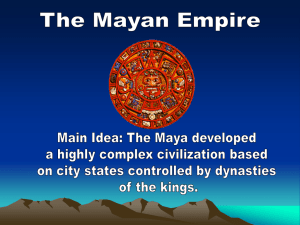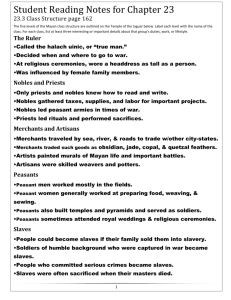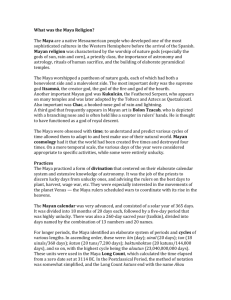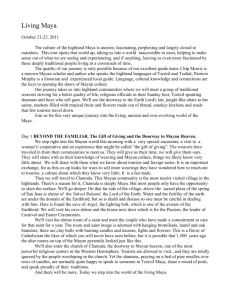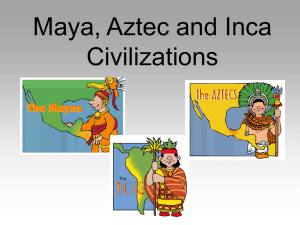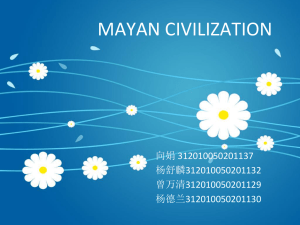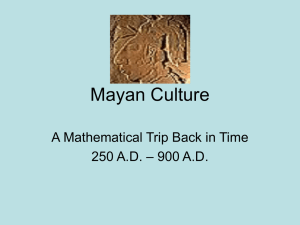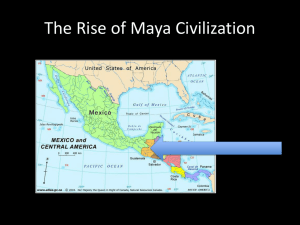Mayan Culture Today Part One
advertisement
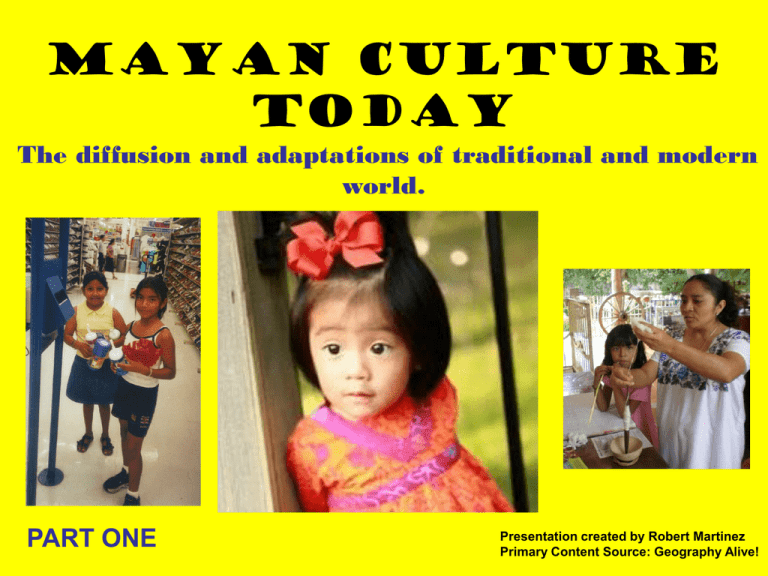
Mayan Culture Today The diffusion and adaptations of traditional and modern world. PART ONE Presentation created by Robert Martinez Primary Content Source: Geography Alive! Several Mayan judges are seated at a table. Two men are standing before them. One man claims that the other killed and ate his chickens. The accused says the chicken entered his yard and ate his chicken feed. Finally, one of the judges speaks up. In the Quiche’ language, he says, “You will pay the man for his chicken by working for three days in his fields.” This story is an example of Mayan community justice. This justice system is one part of the Maya’s deep attachment to their local villages and their strong traditions of self-rule. These traditions are part of what enables Maya to preserve their way of life while adapting to the influences of the modern world. The highland Maya are citizens of either Mexico or Guatemala. Over time, their local communities have adapted to the demands of national life. For example, most highland towns have a mayor who governs the community according to national laws. Many towns have a municipal council that follows Mayan customs. The council members are respected members of the community and make decisions based on traditional values. Mayan towns also have religious brotherhoods. In Guatemala, the brotherhoods are called cofradias. In Chiapas, they are called cargos. These brotherhoods are responsible for guarding the images of Catholic saints and for organizing ceremonies and festivals. The heads of these brotherhoods are also important community leaders. The Maya work hard to keep their communities together. One way they do this is through their justice system. Mayan judges rarely send offenders to jail, which would take those offenders away from their families and hurt the community. Instead, offenders usually pay for crimes through labor or community service, a traditional form of punishment known as restitution. At the same time, the Maya have adapted to national laws. For serious crimes such as murder, Mayan judges turn offenders over to the national courts. In spite of their strong tradition of community problem solving, some Maya face challenges that prompt them to leave the community. Poverty and lack of jobs, schools, and good health care have caused some Maya to move to cities to find work or to get an education. Home and family are the foundations of Mayan life. Most Mayan families live in simple one-room dwellings constructed of wood or mud brick called adobe. But the Maya don’t see a house as just an arrangement of building materials. Rather, they envision their dwelling as a living thing, with a soul like a person. In fact, the Maya believe that everything on Earth is alive. Before they build a house, they hold a ceremony to ask Earth’s permission. A traditional Mayan house is simple on the inside. The floors are made of packed earth, and there is little furniture. A family might own only hammocks for sleeping and a small wooden table and chairs. A cook fire typically sits in the middle of the floor, with a few clay pots by the side. Or there might be a small cookhouse next door to the main house. There is also a family altar for religious worship. Like other aspects of Mayan life, the traditional Mayan home is changing. Some houses in larger towns now have electricity and running water, and some have a radio or a television. Metal and plastic cooking utensils are now common, and some homes even have gas stoves, blenders, and other appliances. There is still a very clear division of labor between men and women in most Mayan communities. The men work in the fields, planting, weeding, and harvesting t he crops, as well as doing occasional hunting. The women work mostly at home, caring for the children and weaving clothes for the family. Women also cook the meals, consisting mainly of beans and tortillas, which most women make the traditional way. They pat the corn dough out by hand and fry it on a griddle. Most children go to school, though many quit at an early age to help out at home. Parents teach their children traditional skills such as farming and weaving, as well as the old customs that children are expected to pass on to their own children. Still, many young Maya also adopt new ways. They may listen to popular music and wear jeans, T-shirts, and sneakers instead of traditional Mayan clothing.

